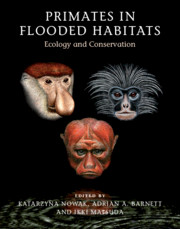Book contents
- Primates in Flooded Habitats
- Primates in Flooded Habitats
- Copyright page
- Contents
- Contributors
- Foreword
- Acknowledgements
- Part I Introduction
- Part II Primates of Mangrove and Coastal Forests
- Part III Beach Primates
- Part IV Swamp Primates
- Part V Primates in Freshwater Flooded Forests
- Part VI Conservation Case Studies
- Part VII Conservation, Threats and Status
- References
- Index
- References
References
Published online by Cambridge University Press: 24 December 2018
- Primates in Flooded Habitats
- Primates in Flooded Habitats
- Copyright page
- Contents
- Contributors
- Foreword
- Acknowledgements
- Part I Introduction
- Part II Primates of Mangrove and Coastal Forests
- Part III Beach Primates
- Part IV Swamp Primates
- Part V Primates in Freshwater Flooded Forests
- Part VI Conservation Case Studies
- Part VII Conservation, Threats and Status
- References
- Index
- References
- Type
- Chapter
- Information
- Primates in Flooded HabitatsEcology and Conservation, pp. 375 - 442Publisher: Cambridge University PressPrint publication year: 2019



